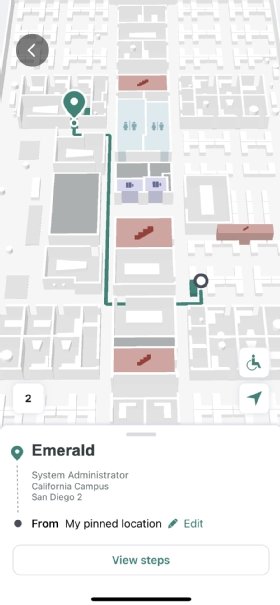Employees returning to the hybrid office can rely on apps, maps and electronic signage to find their desks. These positioning technologies and mapping services are widely called route finding tools, and demand may grow.
Employees returning to the office may need to reserve desks in potentially unfamiliar spaces, and-if a hot desk has become common-their desk locations may vary with each visit. office. They will also need to keep track of co-workers and meeting places in this new organizational structure and they don’t want to waste a lot of time. Vendors use a variety of methods to solve problems caused by hybrid office routines.
The wayfinding products use app-based system maps and electronic signage to orient employees and provide real-time status updates to meeting room residents. Employees can also use this positioning technology to find out the location of coworker desks from one office visit to the next. HR often collaborates with facility managers on their deployment.
Based on research conducted in October, IDC estimates that 20% of organizations worldwide with 500 or more employees may have already invested in wayfinding technology or are planning to do so, said Juliana Beauvais, an analyst at IDC .
“It brings internal navigation technology from a suitable event application, transportation and large retail locations to wider settings such as offices, healthcare campuses, educational institutions and facilities of the public sector, ”he said.
With fewer office trips or a need to work in multiple locations, employees will “start acting like guests,” Beauvais said. These changes will motivate employers to deploy wayfinding products, he said.
Kevin Nanney, vice president and general manager of workplace service delivery at ServiceNow explained, “As employees return to the office, many of them have yet to be seen.”

ServiceNow will simply update the Workplace Service Delivery facility management mobile app with location search services that can guide an employee, step by step, to a desk or meeting room. They use third-party partnerships for internal positioning technology used in wayfinding, Wi-Fi, Bluetooth Low Energy or other technologies to build that capability.
The ServiceNow workplace platform can make reservations for desks, meeting rooms and lockers, as well as services such as catering. Employers can make other employees see employee check-ins. Calendar system integrations make it possible to use the app to see a coworker’s availability. The vendor also added proximity-based reservation capability for sharing reservation itineraries and booking desks near co-workers.
A related aspect of the enterprise wayfinding tool is employee tracking, which can display real-time employee locations. Although a client can add it, real-time employee tracking is not a feature on the ServiceNow workplace platform. But this tracking technology is used.
Real-time employee monitoring
Employee badges, for example, can use Bluetooth-enabled transmitters, powered by coin cell batteries, to send a signal once or twice a second to a receiver. An algorithm can calculate the distance between the person and recipient based on the amount of power received, says Ken Kolderup, chief marketing officer at Bluetooth Special Interest Group (SIG). About two years ago, SIG added direction search, which can calculate the direction of a person’s movement.
Employee data collection systems can be private or open, Kolderup says. They can anonymize employee identity and use the data to track the flow of people to check, for example, office space usage. In some cases, such as for production line or mine workers, location -based employee monitoring can help with safety, Kolderup says.
Companies implementing these systems can create “blackouts” in specific office areas such as bathrooms to prevent surveillance. In fact, Bluetooth can also be used entirely for navigating a building and not for employee tracking, which works similar to GPS on a smartphone.
Although the technology is available to track individual workers, vendors have avoided adding functionality to their platforms due to privacy concerns.
One firm, Avuity LLC, a space utilization software and occupancy sensor firm in Cincinnati, said employee tracking is a concern with companies. “They don’t want to be realized as Big Brother spying on their workers,” a firm spokesman said.
Paul Statham, CEO and founder of Condeco Software Inc., a London-based workspace management vendor, agrees. “It’s very unpopular to track people in buildings,” he said. “This violates many data privacy standards.”

Statham, whose company makes workplace management tools, including room and desk booking systems and calendar software, does not see the need for wireless route finding tools. because they are expensive and complicated. Instead, Condeco Software systems can tell employees what building to enter, where their colleagues are and where they can book a desk or room. He said employees will see the spaces available to them, something HR maps.
Most buildings have “very good visual wayfinding within the floors,” Statham said. People have become accustomed to using signals on their own, he said. He said he also believes road -finding technology is too expensive.
Condeco also has systems that place small screens on a desk with an employee’s name on it to help employees find their desks. It uses meeting room display screens outside the meeting room to deliver information, such as organizer and time.
“We found a way into unfamiliar places like airports and car parks by using very good static signs,” he said.
Patrick Thibodeau covers HCM and ERP technologies for TechTarget. He has worked for more than two decades as an enterprise IT reporter.
